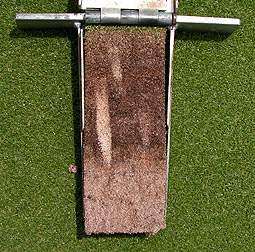The Trouble with Thatch
Thatch is defined as the living and non-living material located between green turfgrass leaves and the underlying soil. Bermudagrass turf in the Florida Region accumulates a large amount of organic matter, and it is best to use the terms "thatch" and organic matter or "mat". In this case, thatch is the layer of turfgrass stems located just below the green leaf canopy and mat is the dark organic material located under thatch. Some thatch and mat is necessary for surface resiliency and nutrient retention, but excessive thatch can cause major issues with playability and turf health.
 |
Excessive thatch and organic matter is a primary stress on bermudagrass putting greens. It causes greens to remain saturated in the upper rootzone, reducing oxygen uptake and encouraging root decline. Saturated conditions also can encourage diseases like Pythium as well.
The old saying " Pay me now or pay me later " is certainly true for managing thatch and organic matter. The inconvenience of paying now and tolerating less than ideal playing conditions for several days is often far less painful than enduring diseased, weak putting greens or large scale turf thinning.
Source: Todd Lowe, tlowe@usga.org or 941-828-2625
